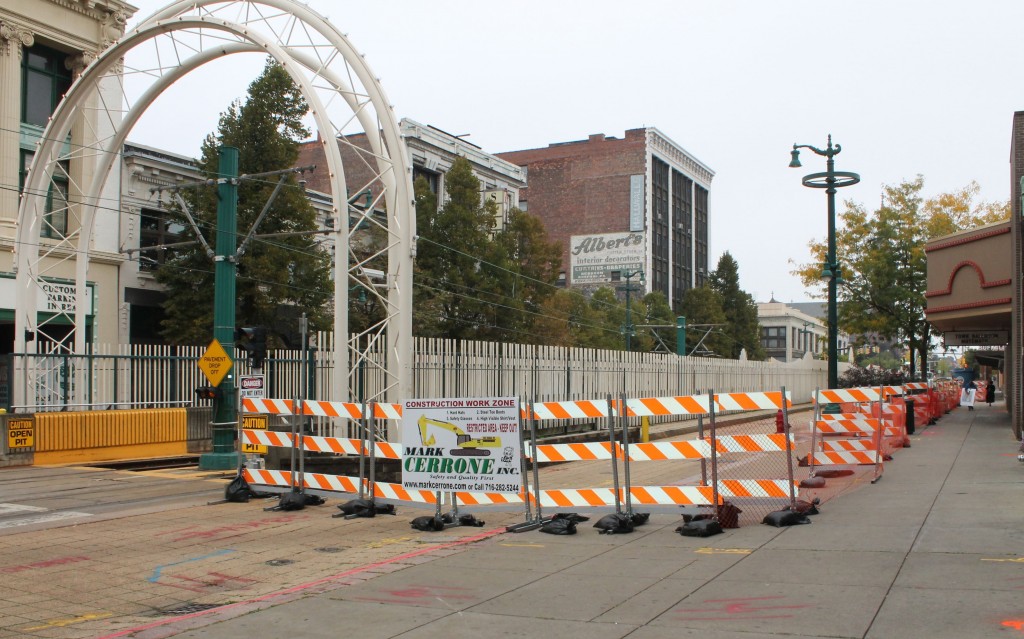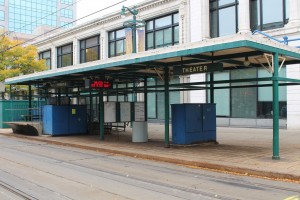Oct 4
2012
Theater District station removal concerns transit group


Construction has begun on the 600 block of Main Street to return vehicular traffic and remove the busy Theater Station, which has upset a local transit group.
One of Mayor Byron Brown’s top goals is to return vehicular traffic to downtown’s Main Street, but his plan for the newest phase that will remove the Theater District Station is drawing flak from the Citizens for Regional Transit.
The Cars Sharing Main Street program violates its own mission of increasing transit ridership by eliminating the station, said Citizens for Regional Transit President Gladys Gifford. The average weekday ridership of the station is about 2,100.
“How are you increasing transit ridership when you remove a station?” Gifford said this week.

The Theater District Station will be removed to allow for vehicular traffic in the 600 block of Main Street.
Gifford said the elimination of a station on the light rail line “constitutes an unintentional form of discrimination” because the majority of transit riders in Buffalo are minority and low-income. She also charged that the project adversely impacts the disabled population and that removing the Theater Station makes the transit system less efficient, which violates the mission of the Niagara Frontier Transportation Authority. The project’s design conflicts with the station’s location, requiring its removal to make way for vehicular traffic.
Read Gifford’s complete letter to FTA administrator Peter Rogoff here. The League of Women Voters Buffalo-Niagara and VOICE-Buffalo cosigned the letter.
The Federal Transit Administration reported that the return of cars increases visibility and access to businesses and employment centers which could boost economic activity, and the improvements will make the area of the 600 block more attractive, active and safer. Property values from 1987 to 2006 have dropped 54 percent in the project area and commercial vacancy rates have increased, according to Buffalo Place. All riders would still have access to the Fountain Plaza Station that is about 550 feet away from the Theater Station, the FTA report states.
FTA Deputy Administrator Therese W. McMillan wrote Gifford Aug. 20, stating that the FTA analysis found the area surrounding the Theater District Station has a large minority and low-income population that is “proportionately larger than the city’s overall low-income population.”
“However, the project was determined not to result in any significant adverse impacts during construction or operation, and rather, could create significant beneficial impacts for the EJ (Environmental Justice) population,” McMillan wrote.
Here is the project’s final design, which says that “combining the Theatre and Fountain Plaza Stations into one location between Huron and Chippewa streets will accommodate the lane transitions around the portal as well as the anticipated traffic conditions.”
The FTA report also states that it doesn’t make economic sense to move the Theater District Station and have it two train lengths from the Fountain Plaza Station. The report also found the project would not increase air pollution concentrations, and that to control dust, the contractor will use water to spray it down and dust covers on the trucks during construction.
According to the city’s website, the primary objective of the project is to reopen a 1.2-mile stretch on Main Street to two-way traffic from Scott Street to Goodell Street, a total of seven stations sharing the roads with vehicular traffic. The program goals are to boost economic development downtown and increase multi-modal options and transit ridership. The entire project will create 209 new parking spaces.
“This will be achieved through higher visibility for retail shops, loading zones for shops and residential areas, and parking availability to allow easier access to buildings on Main Street,” the city website states.
Gifford said she doesn’t think many of the riders are aware that the Theater District Station will be removed.
“At this point, we are not trying to fight it,” she said. “We want everyone to know all of the issues that are involved.”
The Cars Sharing Main Street program will enhance the six above-ground station, according to the FTA report. The enhancements are:
- Heated station platforms.
- Glazed walls for winter weather protection.
- Audio and visual real-time Metro displays.
- New signs and lighting.
- Camera monitoring.
Here is a scope summary of the project, which was developed almost seven years ago.
Earlier this summer, Mark Cerrone Inc. was awarded a $6,271,981 contract to restore one lane of north and south traffic along the 600 block of Main Street between Tupper and Chippewa streets. This project includes about 45 new parking spaces, new loading zones, and about 70 trees and planters. Vehicular traffic will share the track bed with light rail.
The city several years ago completed a $2.2 million project in the 700 block of Main Street between Goodell and Tupper streets. The 500 block (Chippewa to Huron) is estimated to cost at least $20 million, funded with a federal and state grants.
The city hopes to have the entire 1.2-mile project completed in about five years.

